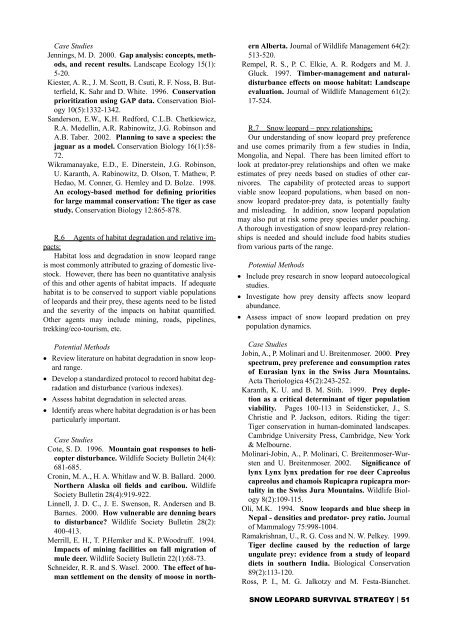Snow Leopard Survival Strategy - Panthera
Snow Leopard Survival Strategy - Panthera
Snow Leopard Survival Strategy - Panthera
You also want an ePaper? Increase the reach of your titles
YUMPU automatically turns print PDFs into web optimized ePapers that Google loves.
Case Studies<br />
Jennings, M. D. 2000. Gap analysis: concepts, methods,<br />
and recent results. Landscape Ecology 15(1):<br />
5-20.<br />
Kiester, A. R., J. M. Scott, B. Csuti, R. F. Noss, B. Butterfield,<br />
K. Sahr and D. White. 1996. Conservation<br />
prioritization using GAP data. Conservation Biology<br />
10(5):1332-1342.<br />
Sanderson, E.W., K.H. Redford, C.L.B. Chetkiewicz,<br />
R.A. Medellin, A.R. Rabinowitz, J.G. Robinson and<br />
A.B. Taber. 2002. Planning to save a species: the<br />
jaguar as a model. Conservation Biology 16(1):58-<br />
72.<br />
Wikramanayake, E.D., E. Dinerstein, J.G. Robinson,<br />
U. Karanth, A. Rabinowitz, D. Olson, T. Mathew, P.<br />
Hedao, M. Conner, G. Hemley and D. Bolze. 1998.<br />
An ecology-based method for defining priorities<br />
for large mammal conservation: The tiger as case<br />
study. Conservation Biology 12:865-878.<br />
R.6 Agents of habitat degradation and relative impacts:<br />
Habitat loss and degradation in snow leopard range<br />
is most commonly attributed to grazing of domestic livestock.<br />
However, there has been no quantitative analysis<br />
of this and other agents of habitat impacts. If adequate<br />
habitat is to be conserved to support viable populations<br />
of leopards and their prey, these agents need to be listed<br />
and the severity of the impacts on habitat quantified.<br />
Other agents may include mining, roads, pipelines,<br />
trekking/eco-tourism, etc.<br />
Potential Methods<br />
• Review literature on habitat degradation in snow leopard<br />
range.<br />
• Develop a standardized protocol to record habitat degradation<br />
and disturbance (various indexes).<br />
• Assess habitat degradation in selected areas.<br />
• Identify areas where habitat degradation is or has been<br />
particularly important.<br />
Case Studies<br />
Cote, S. D. 1996. Mountain goat responses to helicopter<br />
disturbance. Wildlife Society Bulletin 24(4):<br />
681-685.<br />
Cronin, M. A., H. A. Whitlaw and W. B. Ballard. 2000.<br />
Northern Alaska oil fields and caribou. Wildlife<br />
Society Bulletin 28(4):919-922.<br />
Linnell, J. D. C., J. E. Swenson, R. Andersen and B.<br />
Barnes. 2000. How vulnerable are denning bears<br />
to disturbance? Wildlife Society Bulletin 28(2):<br />
400-413.<br />
Merrill, E. H., T. P.Hemker and K. P.Woodruff. 1994.<br />
Impacts of mining facilities on fall migration of<br />
mule deer. Wildlife Society Bulletin 22(1):68-73.<br />
Schneider, R. R. and S. Wasel. 2000. The effect of human<br />
settlement on the density of moose in northern<br />
Alberta. Journal of Wildlife Management 64(2):<br />
513-520.<br />
Rempel, R. S., P. C. Elkie, A. R. Rodgers and M. J.<br />
Gluck. 1997. Timber-management and naturaldisturbance<br />
effects on moose habitat: Landscape<br />
evaluation. Journal of Wildlife Management 61(2):<br />
17-524.<br />
R.7 <strong>Snow</strong> leopard – prey relationships:<br />
Our understanding of snow leopard prey preference<br />
and use comes primarily from a few studies in India,<br />
Mongolia, and Nepal. There has been limited effort to<br />
look at predator-prey relationships and often we make<br />
estimates of prey needs based on studies of other carnivores.<br />
The capability of protected areas to support<br />
viable snow leopard populations, when based on nonsnow<br />
leopard predator-prey data, is potentially faulty<br />
and misleading. In addition, snow leopard population<br />
may also put at risk some prey species under poaching.<br />
A thorough investigation of snow leopard-prey relationships<br />
is needed and should include food habits studies<br />
from various parts of the range.<br />
Potential Methods<br />
• Include prey research in snow leopard autoecological<br />
studies.<br />
• Investigate how prey density affects snow leopard<br />
abundance.<br />
• Assess impact of snow leopard predation on prey<br />
population dynamics.<br />
Case Studies<br />
Jobin, A., P. Molinari and U. Breitenmoser. 2000. Prey<br />
spectrum, prey preference and consumption rates<br />
of Eurasian lynx in the Swiss Jura Mountains.<br />
Acta Theriologica 45(2):243-252.<br />
Karanth, K. U. and B. M. Stith. 1999. Prey depletion<br />
as a critical determinant of tiger population<br />
viability. Pages 100-113 in Seidensticker, J., S.<br />
Christie and P. Jackson, editors. Riding the tiger:<br />
Tiger conservation in human-dominated landscapes.<br />
Cambridge University Press, Cambridge, New York<br />
& Melbourne.<br />
Molinari-Jobin, A., P. Molinari, C. Breitenmoser-Wursten<br />
and U. Breitenmoser. 2002. Significance of<br />
lynx Lynx lynx predation for roe deer Capreolus<br />
capreolus and chamois Rupicapra rupicapra mortality<br />
in the Swiss Jura Mountains. Wildlife Biology<br />
8(2):109-115.<br />
Oli, M.K. 1994. <strong>Snow</strong> leopards and blue sheep in<br />
Nepal - densities and predator- prey ratio. Journal<br />
of Mammalogy 75:998-1004.<br />
Ramakrishnan, U., R. G. Coss and N. W. Pelkey. 1999.<br />
Tiger decline caused by the reduction of large<br />
ungulate prey: evidence from a study of leopard<br />
diets in southern India. Biological Conservation<br />
89(2):113-120.<br />
Ross, P. I., M. G. Jalkotzy and M. Festa-Bianchet.<br />
SNOW LEOPARD SURVIVAL STRATEGY | 51
















